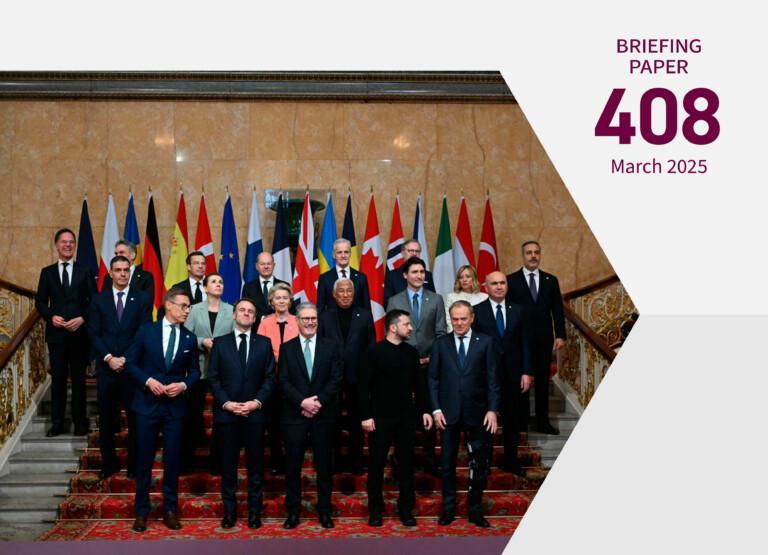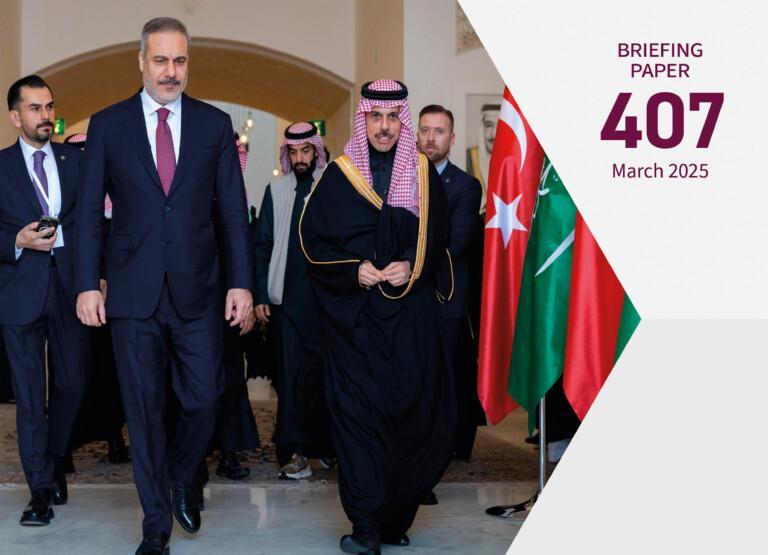
Three main factors will determine the shape of the next European Parliament (EP): the outcome of the elections, the organisation of national parties into supranational political groups, and developments in the Brexit process. Everything points towards some significant changes – and a considerable degree of uncertainty – in the new EP.
The EP’s centre-right and centre-left groups are expected to lose their combined majority for the first time since 1979, whereas far-right parties and liberal democrats will likely increase their representation. The EP’s mainstream groups will therefore need new allies to achieve majorities, which could boost the influence of the smaller groups.
The choice of the next Commission President will be the first major test for the new EP. While most political groups have designated candidates, it is unclear whether the Spitzenkandidaten system will be followed.
If and when it takes place, Brexit will have an impact on the size of the EP, reducing it from 751 to 705 seats, as well as on the composition of the political groups that include British parliamentarians.
Introduction
In most EU member states, European Parliament (EP) elections tend to be seen as less important than national elections. However, several factors have increased the significance of the upcoming EP elections, which will be held between 23 and 26 May 2019.
The elections will take place at a critical time for the European Union. Ten years have passed since the beginning of the economic and financial crisis, which has had a strong impact on Southern member states in particular, weakening the traditionally strong pro-European orientation of their citizens. Subsequently, a series of other major crises occurred, concerning the Eurozone, migration, relations with Russia, Brexit and the partnership with the United States. Many of these crises have had a predominantly negative effect on intra-EU solidarity, and have facilitated the ongoing rise of far-right and Eurosceptic political parties. Thus, as EU citizens go to vote in May 2019, the future of European integration and of the values underpinning it are subject to heated debates and uncertainty.
Moreover, the EP elections will have repercussions for national politics in several member states. For instance, they have been framed as important tests for the continuation of current coalition governments in Italy and Germany, as well as for Emmanuel Macron’s policies and leadership in France. Elsewhere, as in Poland, they are seen as a trial for the national elections that will take place later in 2019. In Estonia, Finland and Spain, by contrast, the EP elections have been largely overshadowed by recent national elections. Consequently, election campaigns and debates in almost all member states have continued to focus primarily on national topics and dividing lines.
At the same time, some pan-European themes have emerged in the campaign, including migration, the European economy, climate change and internal security. In the run-up to the election, the main European political groups have attempted to frame common positions on these topics in manifestos and programmes.1
In Brussels, the EP elections are regarded as the prelude to a year of institutional transition in the EU. Besides leading to the formation of the new European Parliament, they will also influence the appointment of the new Commission President. The Parliament also has to approve the entire new Commission, including the High Representative of the Union for Foreign Affairs and Security Policy. The ensuing institutional balance of power can also play a role in the choice of the new European Council President when Donald Tusk’s mandate expires in November 2019.
This Briefing Paper focuses on the immediate political significance of the upcoming EP elections. Most importantly, it analyses the three main factors that will determine the shape of the next European Parliament: the outcome of the EP elections, the way in which the newly elected Members of the European Parliament (MEPs) from different national parties organise themselves within supranational political groups, and the unfolding of the Brexit process. Developments with regard to all three point to some significant changes – and a considerable degree of uncertainty – for the new EP. The consequences of these changes for the functioning of the EP are then briefly discussed in the last part of the paper.
EP elections as a reflection of Europe’s changing political landscapes
The results of the elections dictate the basic composition of the EP. In recent years, the political landscapes of most EU member states have witnessed notable changes and, in some cases, radical transformations. In general, European party political systems are characterised by an increasing level of fragmentation, meaning that there are more parties competing for political power and fewer big parties with broad societal appeal. This manifests itself in the weakening of the traditional major parties of the centre-left (socialist and social democratic parties) and the centre-right (conservative and Christian democratic parties), increasing support for parties of the populist radical right, as well as the emergence of new parties, including both mainstream parties and populist parties.
These developments can be observed, in varying forms and to varying degrees, in almost all of the EU’s large member states, with the partial exception of the UK. In Germany, the two traditional Volksparteien, the Christian Democratic Union (CDU) and the Social Democratic Party (SPD), have both seen their voter base shrink, with the SPD facing the heaviest losses. At the same time, support for the increasingly centrist Greens and the far-right Alternative for Germany (AfD) has risen. In France, the Socialist Party (PS) has been relegated to the political margins by the rise of Emmanuel Macron and his centrist La République en Marche! party (LREM), whereas Marine Le Pen’s populist radical right National Rally has established itself as Macron’s main challenger.
In Italy, the current government is formed by the populist Five Star Movement (M5S) and the far-right League, both of which have risen at the cost of traditional centre-right and centre-left forces. In Spain, the bipartisan system around the conservative People’s Party (PP) and the centre-left Socialist Workers’ Party (PSOE) has crumbled, as the centre-right Ciudadanos, left-wing Podemos and, most recently, far-right Vox have entered the political fray. Political fragmentation and the emergence of populist challengers has also reshaped the political landscapes, amongst others, in Greece, Finland, the Netherlands and Sweden.
The results of the 2019 EP elections will reflect these broad European trends. Such trends may even be amplified by the EP elections’ persistent status as second-order national elections, which generally results in lower turnouts, a higher degree of volatility and better results for smaller, more extreme and opposition parties.2 Traditional major parties of the centre-right and particularly of the centre-left are therefore likely to see their support decrease. Meanwhile, far-right parties are projected to do well in a number of member states, including Austria (the Freedom Party, FPÖ), Finland (the Finns Party, PS), France (National Rally), Germany (AfD), Hungary (Fidesz), Italy (League), the Netherlands (Forum for Democracy, FvD), Poland (Law and Justice, PiS) and Sweden (Sweden Democrats). At the same time, some new and established mainstream parties are also likely to make headway, led by Macron’s LREM, the Spanish Ciudadanos and the German Greens.
However, it is important to note that this transformation of European political landscapes already emerged during the 2014 EP elections. Populist or anti-establishment parties such as the UK Independence Party (UKIP), France’s National Front (now National Rally), the Danish People’s Party (DF), Greece’s Syriza and Italy’s M5S significantly increased their representation at the cost of established centre-left and centre-right parties. As a consequence, the 2019 EP elections will be more of a continuation of a longer-term trend than a surprising turn of events.
New power relations within the EP: changing majorities
The results of the EP elections will directly affect the configuration of, and power relations between, the political groups that have a crucial role in guiding and organising the EP’s work. While the political groups remain compounds of national parties, most of them have developed into coherent political entities that help to conciliate the interests of their members and organise majorities in the EP’s plenaries.3 At the same time, the size of the individual political groups is an important factor when key positions within the EP (presidency and vice-presidencies, committee chairpersons and vice-chairpersons, rapporteurships) are distributed.
Two political groups have traditionally dominated the EP, a centre-right group currently called the European People’s Party (EPP) and a centre-left group now known as the Progressive Alliance of Socialists and Democrats (S&D). Together, these groups have held the majority of EP seats since the first direct elections in 1979, and cooperation between them has been a crucial component of politics in the EP throughout several legislative cycles. While there are no formal coalitions within the EP, an informal and pro-integrationist grand coalition of the EPP and S&D has often formed the basis of majorities within the parliament, particularly in the last EP.
However, current projections suggest that due to the declining support for traditional centre-right and centre-left parties, the EPP and S&D are on course to lose their combined majority. The EPP is likely to remain the largest group within the EP, but it could lose around 50 of its current 217 seats. The S&D, for its part, could see a drop from 184 to somewhere between 140 and 150 seats, although it would retain its position as the second-largest group.
The weakening of the duopoly of the EPP and S&D will have a significant impact on the political dynamics within the EP. The most likely winner would be the centrist, liberal and pro-integrationist Alliance of Liberals and Democrats for Europe (ALDE) group, which is the most obvious partner for the EPP and S&D. In the past, it often aligned with the EPP and S&D – or with one of them if the two did not reach an agreement – but is now set to become decisive in forming a majority, providing it with new leverage. Unlike the EPP and S&D, ALDE is likely to retain its current seats and may even gain new MEPs, especially if the Spanish Ciudadanos and the German Free Democratic Party (FDP) do well in the EP elections. The single most decisive factor in terms of ALDE’s future will be whether Macron’s LREM – which has built close links with ALDE – will join its ranks in the new EP or try to form a group of its own, thereby potentially attracting parties that are currently part of ALDE.
The question about the LREM’s place within the EP’s political setting shows that the power relations within the parliament are not decided solely by the election result. Instead, the standing of the individual political groups also depends on their ability to hold onto their members and attract new ones, both among established parties and new, non-attached ones. Shifts between individual political groups and the accommodation of new parties, as well as the establishment of new political groups and the rebranding of existing ones, are all typical features of the EP’s post-election period. To form a political group, 25 MEPs from seven different member states are necessary.
Among the other parliamentary groups, the Greens/European Free Alliance and the Left (European United Left/Nordic Green Left, GUE/NGL) are expected to win a similar number of seats as in 2014. Due to the new political constellations in the EP, they could also play a more pronounced role in achieving majorities on certain issues.
Expected developments on the (far) right
In the run-up to the 2019 EP elections, group formation and branding processes on the EP’s right fringe in particular have received significant media attention. Although various right-wing Eurosceptic parties significantly increased their representation in the 2014 EP elections, the EP’s right-wing Eurosceptic camp has remained very fragmented. Currently, it is divided into three different political groups, the European Conservatives and Reformists group (ECR, currently holding 75 seats), the Europe of Freedom and Democracy group (EFDD, 41 seats) and the Europe of Nations and Freedom group (ENF, 37 seats).4 These groups initially differed above all with regard to their stance on European integration (ranging from the soft Euroscepticism of the ECR to the hard Euroscepticism of the EFDD and ENF), but also in view of many substantive policy issues as well as personal relationships. Moreover, the EFDD and ENF groups in particular have been characterised by low levels of internal cohesion, further decreasing their credibility and influence.5
However, ahead of the 2019 EP elections, some visible figures have campaigned for unifying the EP’s Eurosceptic, national-conservative and far-right parties – or at least as many of them as possible – under a common umbrella. Whether or not this would entail the establishment of a single political group or simply a loose alliance still seems somewhat unclear.
The unification effort has been most visibly spearheaded by the leader of Italy’s League, Matteo Salvini. His standing is strengthened by his party’s strong position in the polls, which could turn League into one of the biggest national party delegations within the EP. On 8 April, Salvini announced the launch of a broad alliance of Eurosceptic and populist parties that would then lead to the establishment of the largest right-wing group within the EP. The basis of this alliance would be formed by the League’s partners within the ENF group, most notably the National Rally and the Austrian FPÖ, but also parties that currently sit in other political groups, such as Germany’s AfD, Finland’s PS and Denmark’s DF.
Following the Brexit vote, polls show that on average EU citizens have become more supportive of EU membership.6 Due to this and to expectations of acquiring more influence in the EU institutions after the 2019 EP elections, many Eurosceptic and far-right parties have abandoned calls for leaving the EU or the Eurozone. Instead, they now underline that they want to radically reform the EU or Europe more broadly, an idea that was echoed by Salvini when he announced the launch of his new alliance.7 This approach might help the Eurosceptic parties overcome previous divisions based on their view of the European integration process.
On the other hand, substantive differences on several key issues – including fiscal and economic policy, migration policies, societal values and relations with Russia – remain. Moreover, many of the far-right parties are strongly centred on one key political figure, which means that personal relationships also matter. These factors have made it difficult thus far for the Eurosceptic and far-right parties to unite their forces, and they are likely to complicate such efforts also in the future.
Nevertheless, the expected electoral success of Salvini’s League and some of its partners, the emergence of new Eurosceptic and populist radical right parties (such as Spain’s Vox), and the potential shifts within Eurosceptic groups following Brexit are likely to lead to the formation of a bigger political group of populist radical right parties. However, it is unlikely that all the EP’s Eurosceptic and far-right groups will join it. Another crucial question is whether, and to what extent, these parties will be able to cooperate across political group lines and adopt tactics that boost their influence in the EP.
The impact of Brexit
The Brexit process is the third main factor that will affect the composition of the next EP. The eventual departure of the UK and the British MEPs will lead to changes in the overall size of the EP, in the division of EP seats between the remaining member states as well as in the composition of the EP’s existing political groups, several of which have a sizeable British representation.
While it was expected that the UK would leave the EU well before the 2019 EP election, the domestic Brexit deadlock forced the British government to seek an extension of its membership. On 12 April 2019, a six-month extension was announced, meaning that the UK will most likely have to hold an EP election. This adds an element of considerable uncertainty to the functioning of the next EP, which is likely to face the withdrawal of the British MEPs and the resulting changes in its composition at some point during the next legislative cycle.
With the UK taking part in the EP elections, 751 MEPs will be elected, including 73 British MEPs. When the UK leaves, the size of the EP will be reduced by 46 seats, to 705 MEPs. Twenty-seven of the UK’s 73 seats will be reallocated to other member states: five to France and Spain, three to Italy and the Netherlands, two to Ireland and one each to nine other member states. The European Council adopted the decision on the new allocation of seats in June 2018, based on a proposal by the EP.8
Reallocating seats during the legislative cycle will be an administrative challenge. Most significantly, many commentators and politicians from the other 27 EU member states question the political rationale of electing British MEPs with the awareness that they will soon be leaving the house. Some even fear that the new British pro-Brexit MEPs could play a disruptive role in the next EP.9
Recent polls on voting intentions in the UK substantiate this concern. Nigel Farage’s new Brexit Party could be the largest party and duly form a sizeable delegation of MEPs. The Labour Party is likely to receive more votes than in 2014, whereas the Conservative Party appears to be the main loser. Some supporters of the UK’s EU membership have expressed the hope that the EP election will be framed domestically as a “second EU referendum by proxy”, and will see a victory for parties that want to revoke Brexit. However, this scenario appears unlikely at the moment.
Based on current alliances and polls, in the new EP British MEPs would constitute an important delegation especially within the EFDD group (with the Brexit Party/UKIP), then within the S&D (Labour Party), ECR (Conservative Party) and Greens/EFA groups (with both the Green Party and the Scottish National Party). Eventually, Brexit and the departure of British MEPs could cause the collapse of the EFDD group and (further) weaken the S&D and the Greens/EFA. Moreover, it will both weaken the ECR group and shift its weight towards its more right-wing Eastern European members, as the Polish Law and Justice party will remain as the only large national delegation.
The EP after the May 2019 elections
The election of the new Commission President will be the first major test for the new EP. In 2014, most EP groups were united in their support for the Spitzenkandidaten procedure in order to strengthen the EP’s position in the election of the Commission President and vis-à-vis the Commission in general. Especially at the beginning of his mandate, Commission President Jean-Claude Juncker therefore had a strong relationship with the EP and the leaders of the EPP and S&D in particular.
In the run-up to the 2019 EP elections, the EPP and S&D have appointed their Spitzenkandidaten – Manfred Weber and Frans Timmermans, respectively. The ECR, Greens/EFA and Left groups have designated candidates too. Conversely, ALDE has presented a list of seven candidates. Some commentators see this choice as an attempt to disrupt the Spitzenkandidaten system, which boosts the chances of candidates of larger party groups. Significantly, potential ALDE ally Macron has rejected this system too.10
Moreover, the European Council continues to insist there is no automatism by which the Spitzenkandidat of the largest party becomes Commission President. Hence, the European Council may propose a different candidate in post-election negotiations. If this happens, however, the Council will also have to persuade the EP, which could otherwise refuse to elect the proposed candidate.11
In general, the expected post-electoral fragmentation of the EP could have an impact on its functioning and relationship with other EU institutions. Due to reliance on a weaker majority, the new EP could become a more difficult negotiation partner for the Council and the Commission. This could further tilt the institutional balance in favour of the European Council, thereby accentuating the trend that characterised EU decision-making during the multiple crises of recent years. On the other hand, the EP has clear prerogatives as co-legislator (together with the Council), which have in fact been strengthened by the Lisbon Treaty.
Conclusion: European and national developments
The 2019 EP elections are likely to broadly reflect the trends already observed in national elections in recent years. Mainstream centre-right and centre-left parties are expected to lose votes, but will continue to form the larger political groups and will presumably seek cooperation with smaller, pro-integrationist forces to achieve majorities.
The far right is expected to strengthen its representation and potentially be more united than in the past, although the emergence of a single Eurosceptic political group appears unlikely. Despite their stronger position, far-right parties will remain in the EP’s ‘opposition’, and their influence on day-to-day politics will depend on internal cohesion, engagement in legislative work and the ability to bridge the substantive differences that continue to exist between them on topics such as fiscal and economic policies.
Overall, greater political fragmentation and weaker and shifting majorities will affect the EP’s decision-making process. Moreover, the EP may have to face proposals from the European Council or member states to abandon the Spitzenkandidaten system, which would risk weakening the EP’s political influence. Brexit and the ensuing changes in the EP’s composition constitute a further challenge.
Finally, the EP elections can also have important repercussions for governing coalitions in several member states. As the election campaign is conducted primarily along national lines and on national topics, the vote is perceived as a domestic test for incumbent governments. Electoral results may induce governing parties in countries such as Italy and Germany to seek new coalition partners or even call for national elections.
References
1 For a detailed discussion, see Pascal Lamy et al., The Proposal of the Main European Political Families on the Major Themes of the European Election Campaign, Notre Europe, March 2019.
2 Nicolò Fraccaroli and Nils Hernborg, 'European Parliament election projections may be underestimating support for Eurosceptic and Green parties', LSE EUROPP blog, 17 April 2019, https://blogs.lse.ac.uk/europpblog/2019/04/17/european-parliament-election-projections-may-be-underestimating-support-for-eurosceptic-and-green-parties/.
3 Nicolai von Ondarza and Felix Schenuit, Shadows over the European Elections: Three Scenarios for EU-sceptical Parties after the 2019 Elections, p. 2, https://www.swp-berlin.org/fileadmin/contents/products/comments/2018C50_orz_sux.pdf.
4 An additional group of extremist MEPs did not join any of these groups and remain non-attached.
5 VoteWatch, 21 January 2019, https://www.votewatch.eu/blog/which-ep-political-groups-are-actually-fake/.
6 EP Special Eurobarometer 91.1, spring 2019, http://www.europarl.europa.eu/at-your-service/files/be-heard/eurobarometer/2019/parlemeter-2019/executive-summary/en-parlemeter-2019-executive-summary.pdf.
7 Maïa de la Baume, 'Salvini aims high with populist alliance for Europe', Politico, 8 April 2019, https://www.politico.eu/article/salvini-aims-high-with-populist-alliance-for-europe/.
8 See European Parliament, http://www.europarl.europa.eu/news/en/faq/12/how-many-meps. As a result of Brexit, Finland will also have an additional MEP.
9 See 'EU parliamentary elections and the Brexit headache', France24, 21 April 2019, https://www.france24.com/en/20190421-brexit-uk-european-election-eu-british-mep-parliamentary-seat-farage-may.
10 Maïa de la Baume, ‘Leading liberals join EU election fray’, Politico, 19 March 2019, https://www.politico.eu/article/vestager-verhofstadt-bonino-eu-election-european-union-parliament-commission-alde-spitzenkandidat/.
11 Another option that has been gaining momentum, and that may receive further consideration in future years, is the direct election of the Commission President. This system could strengthen the Commission’s political position and democratic legitimacy. See Teija Tiilikainen, 'The Concepts of Parliamentarism in the EU’s Political System, FIIA Working Paper 108, April 2019, p. 11.












